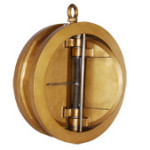DUAL PLATE CHECK VALVES
Design Features | Construction Features | Advantages | Application | Installation Dimensions
Design Features
The Dual Plate Check Valve is an all purpose non return valve that is much stronger, lighter in weight and smaller in size compared to a conventional swing check valve or lift check valve.
The Dual Plate Check Valve design is the outcome of attempts to solve the problems associated with conventional swing check valve and lift check valve. The Dual Plate Check Valve employs two-spring-loaded plates hinged on a central hinge pin. When the flow decreases, the plates close by the action of torsion spring before flow reversal takes place. This design offers the twin advantages of No Water Hammer and Non Slam simultaneously. All features put together make the Dual Plate Check Valve as the most efficient & versatile design. It is also referred to as SILENT CHECK VALVE
Dual Plate Check Valve can be classified as Zero Velocity Valve . The design has everything which the other conventional valves miss. It is a valve most efficient in operation irrespective of fluid and service conditions and the easiest to handle and install in any piping system with no constraints.
NO WATER HAMMER
To eliminate water hammer, a Check Valve should close before the onset of reverse flow. Water hammer is almost non existent in dual plate check valves since closing of the valve does not depend on back pressure and back flow. Each plate being half the size of a swing check disc provides a straight flow path, offering least resistance. Due to spring assisted closing, valve closure starts as soon as flow velocity reduces below the designed minimum velocity and thereafter the closing rate flows the flow velocity reduction pattern. The valve closes as the flow velocity approaches zero and well before the flow reverses. This eliminates water hammer.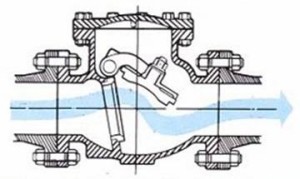
In the figure the Heavy Disc in Swing Check Valves develops heavy momentum as it swings to the closed position.
NO SLAMMING
The Dual Plate Check Valve design is classified as “Non-Slam Design”. The disc in a swing check valve is hinged at the top. As the flow reduces, the closure of disc is influenced by force of gravity and high inertia of the heavy disc. This momentum can cause severe damage when the disc slams on to the valve seat. To reduce this, one has to go for a balancing weight/dash pot arrangement etc. This makes the valve more expensive and bulky. Furthermore, any counter weight/dash pot arrangement is counter productive as far as prevention of water hammer is concerned.
The two plates in Dual Plate Check Valve are hinged in the center vertically for horizontal installations, altogether eliminating the effect of the gravity. Also the momentum developed as they move to the closed position is only a fraction of what is developed in a swing check valve as the weight of each plate is ¼th the weight of swing disc and the tip velocity is less than half. Further due to spring assisted closing, the valve closes as the flow velocity approaches zero and before the flow reversal. As it starts closing, the flow as such cushions the plates and seat, hence minimizing slamming.
INDEPENDENT PLATE SUSPENSION
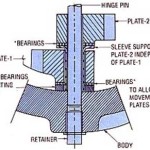 For valve sizes 450mm (18″) NB and above, each plate is supported independent of each other. In any position (Horizontal or Vertical) each plate’s weight is directly transferred to the body.
For valve sizes 450mm (18″) NB and above, each plate is supported independent of each other. In any position (Horizontal or Vertical) each plate’s weight is directly transferred to the body.
LOWER PRESSURE DROP
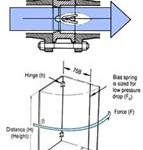 The design of the Dual Plate Check Valve divides the total force in half , since each plate covers only one half the area of a swing check disc. One half the force on each plate requires one-half thickness, hence one-fourth the mass of a swing check disc.
The design of the Dual Plate Check Valve divides the total force in half , since each plate covers only one half the area of a swing check disc. One half the force on each plate requires one-half thickness, hence one-fourth the mass of a swing check disc.
Ff (hinge friction) plus Fs (spring force) times 0.75B (force point) minus F ( force) times B (width) equals zero for equilibrium .
Ff (Friction of Hinge) + Fs (0.75B) – FB = 0
Therefore,
F = 0.75 Fs + Ff (Friction of Hinge)
B
The weight of the plates does not increase the force required to move the plates.
Dual Plate Check Valve has much lower pressure drop due to lower force. The best analogy between a swing check valve and Dual plate Check Valve would be a door hinged from the top and a door hinged on its side with an appropriate door closure. The force required for operating the two doors can be just visualized and compared.
LOWER WEAR & TEAR OF SEAT FACES
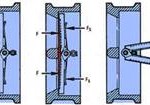 The plates are smaller in area and lighter in weight being two in number compared to one in a conventional swing check valve. The unique feature of plate opening (i.e., it first lifts up at heel and then swings) ensures no rubbing actions against seat. This results in lower rate of wear and tear of seals. This features is not feasible in other designs which results in a higher rate of seal wear. This is achieved by the special spring action and hinge design.
The plates are smaller in area and lighter in weight being two in number compared to one in a conventional swing check valve. The unique feature of plate opening (i.e., it first lifts up at heel and then swings) ensures no rubbing actions against seat. This results in lower rate of wear and tear of seals. This features is not feasible in other designs which results in a higher rate of seal wear. This is achieved by the special spring action and hinge design.
FLEXIBLE INSTALLATION 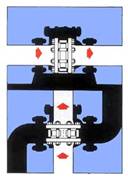
The installed valve is more rigid that an equivalent length of heavy section pipe eliminating the need for any special support etc. The spring action (in place of gravity) enables the valve to be installed in any position – vertical or horizontal.
HEAD LOSS V/S FLOW RATE
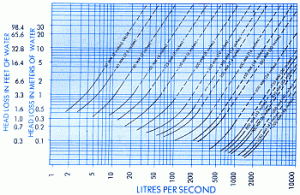 Through R & D efforts, improvement & optimisation of design is an ongoing process. The design / specifications provided here are subject to change accordingly.
Through R & D efforts, improvement & optimisation of design is an ongoing process. The design / specifications provided here are subject to change accordingly.
Construction Features
DESIGN STANDARD
The Valve design conforms to API 594 as well as API 6D except face-to-face dimensions of ANSI 125 cast iron valves of sizes 65mm (21/2″) to 300mm (12″). Dual Plate Check Valves are available in wafer design, flanged wafer design and extended design with flanged ends having face-to-face dimensions as that of a swing check valve.
| Resilient Seal | Metal to Metal Seal |
 |
SEAL DESIGN
Metal to Metal and Soft Seating are available. Soft Seats are integrally moulded type and Metal Seats are either integral or over layed.
Special Service Valves
- RUBBER-LINED VALVES : To meet special service requirements “Advance” Dual Plate Check Valves are available in fully rubber lined bodies, whereas internals can be of suitable alloys to meet the fluid environment .
- HIGH TEMPERATURE SERVICES : To take care of differential expansion between body and long studs in High Temperature Services, double flanged valves are available where standard set of studs can be used at each end. This design automatically eliminates the need for separate Lug Type Design.
- Valves tested for fire Safe Services as per International Standards, Vaccum tested for Vaccum Services and Statutory approved Valves for Boiler applications are available.
- LUG Type Valves are also available on request.
Advantages at a Glance
|
DUAL PLATE CHECK VALVE |
SWING CHECK VALVE |
|
|
Applications
The Dual Plate Check Valve is the most versatile design available in specific materials of construction to suit particular Pressure, Temperature and Fluid Flow Characteristics. Some of the Typical Applications are as follows :
| Water | Water Supply Systems, Fire Water Systems, Cooling Water, Chilled /Hot Water Systems, Boiler Feed Water, Sea Water, Potable Water, Raw Water etc |
| Hydrocarbons | All applications |
| Oil & Gas | Onshore/ Offshore, Petroleum, Lubricating oil, Hydraulic oil, Edible Oils, LPG, Sour Gas, Low Temperature Applications etc. |
| Air & Gases | All Gases like Chlorine, Hydrogen, Nitrogen, Carbon Dioxide (CO2) etc. |
| Metallurgical & Chemical processes | Sugar, Pharmaceutical, Paper, Cement, Steel, Aluminium, Copper, Zinc, Power and other Industries. |
There is a solution to almost all NON-RETURN (Check Valve) problems, varying from Fire Safe services to Cryogenic conditions, with a suitably designed Dual Plate Check Valve.
Through R & D efforts, improvement and optimization of design is an on-going process . The design/specifications provided here are subject to change accordingly.
Installation Dimensions
DIMENSION TABLE UNDER UPDATION IN THE MEANTIME PLEASE REFER PRODUCT CATALOGUE

